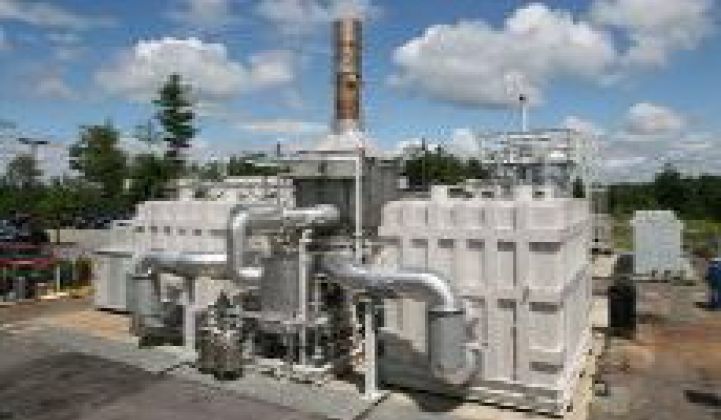Going by headlines, one would think that Bloom Energy invented fuel cells and pioneered their commercialization. In reality, fuel cells were invented in the 1800s and there is a large crowd of fuel cell firms going after the same stationary fuel cell market. They have in common a strong technological focus, a dependence on subsidies, and a tendency to lose enormous sums of money. Vendors in this sector include FuelCell Energy, UTC, ClearEdge Power, Acal Power, Ceres Power, and Idatech.
We've covered the fuel cell industry in this market summary and we've looked at Bloom's ability to garner subsidies, amongst many other articles on this sector.
FuelCell Energy (Nasdaq:FCEL), a 441-employee fuel cell power plant manufacturer, had revenues of $28.1 million in the first quarter of 2011 and will be announcing its Q2 results on June 7. Net loss for the first quarter of 2011 was $11.7 million. The firm reported revenue of $69.8 million in 2010 compared to $88.0 million in 2009. Net loss for 2010 was $58.9 million.
FuelCell Energy builds molten carbonate stationary fuel cells for use at wastewater treatment facilities, universities, pump stations and other sites that need low-emission baseload distributed generation. Production levels are currently at 35 megawatts annually compared to production of 22 megawatts in 2010.
FCE received some good news this week. POSCO Power, an independent power producer based in South Korea, placed a two-year, 70-megawatt, $129 million order comes for the firm's fuel cell kits. POSCO Power is a subsidiary of POSCO, a global steel producer. This is the largest order ever received by FuelCell Energy.
South Korea adopted a renewable portfolio standard (RPS) in 2010 with 350 megawatts of renewable energy per year mandated through 2016, and 700 megawatts per year through 2022. Fuel cells operating on natural gas and biogas fully qualify under the RPS.
POSCO Power will assemble the fuel cell components to create the fuel cell module and add electrical and mechanical balance of plant to complete the power plant. In addition to the revenue generated by the sale of fuel cell kits, FuelCell Energy receives a royalty for each complete power plant built and installed by POSCO Power, under a licensing agreement signed in 2009. Including this order, POSCO Power has ordered 140 megawatts of fuel cells.
Bad news looming in the upcoming Q2 results is the non-recurring charge of $9 million to repair and upgrade a group of 1.2-megawatt fuel cell modules produced between 2007 and early 2009. The upgrade stems from a performance shortfall due to a type of sealant and design, not the stack itself. In total, 16 modules totaling 19.2 megawatts will be affected with 14 of the modules located in South Korea and the remaining two modules located in the U.S.
FuelCell Energy's stock jumped more than 35 percent on the news on Tuesday, but settled down to $1.77 per share on Wednesday.
Declining prices, government incentives, demand for cleaner power and improving technology have begun to revive the fuel cell industry. In the U.S., fuel cell incentives include a federal tax credit for 30 percent of the cost of a fuel cell. California kicks in another $2.50 per watt. The U.K. has a feed-in tariff for micro CHP, which readily applies to fuel cells.
Without a doubt, there are some applications for which fuel cells make perfect sense, such as premium power for the military, remote sites, construction industry, travel, etc. But fuel cell firms have learned the hard way that they must focus on the requirements of specifically addressed niche markets.
Here, again, is an updated list of the top three profitable publicly held fuel cell firms:
1.
2.
3.
Maybe we'll see some profitable fuel cell companies in 2011 or 2012.



